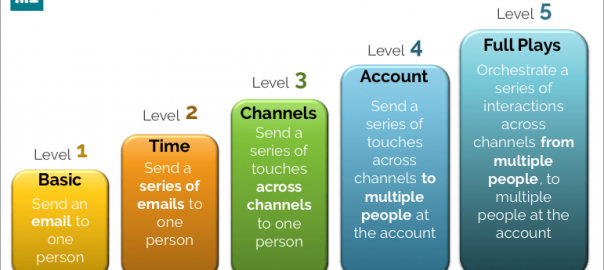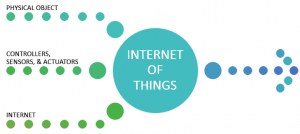
You likely have a particular goal in mind for each of your target accounts.
You may want some accounts to take a meeting, others to renew, and others to become an advocate for you. Regardless of the objective, pre-sale or post-sale, in order to achieve the goal you’re after, you need engagement.
No matter what you’re trying to achieve, engagement is the driving force within every stage of a customer’s lifecycle with your company. Successful organizations today are led by marketers who think about ways to orchestrate the right people in their business to interact with the right people at target accounts in a way that drives engagement.
It’s all about coordinating personalized Marketing, Sales and Customer Success efforts to open doors and deepen engagement at specific accounts. We call these efforts “Plays” and they generally fall into one of five levels of sophistication (and effectiveness). The more advanced, the more orchestration and coordination are necessary.
Level 1: Basic
Send an email to one person
At the simplest level, within the first level of account orchestration, one person from your company is sending one email to one person at the account. You may do it directly using Gmail or Exchange, or use a tool like Hubspot Sidekick or Marketo Sales Insight to find out if that email was opened. Your main goal here is to ask someone for something.
Level 2: Time
Send a series of emails to one person
At Level 2, you’re sending a series of emails from one person to another person. This is useful insofar as if someone doesn’t respond to the first email, you can automatically follow up with multiple emails following your first message. You can automate this with a lead-based sales email tool like ToutApp or Yesware to achieve this goal (although whether one can use automation to create genuine human connections is questionable).
Level 3: Channels
Send a series of touches across channels to one person
At this level, one person from your company uses a variety of channels to reach one person. This could include a series of emails, phone calls, and perhaps social touches. Mixing it up works better as not everyone responds over email, for example, and various channels can reinforce each other. You may use technology here including Outreach and Salesloft.
Level 4: Team
Send a series of touches across channels from multiple people and teams.
In Level 4, rather than one lone SDR working to engage an account, Marketing is involved in orchestrating Plays that may include ads, direct mail pieces, events, that complement the email, phone, and social touches. At this level, you also bring in touches from other people in the organization, including the AE and executive outreach where appropriate. In this level, you’re team selling, using every resource in the organization to achieve the goal of the play.
Level 5: Full Plays
Orchestrate a series of interactions across channels from multiple people, to multiple people at the account.
At Level 5, you have adopted the fact that we are not living in a lead-based world. At this level, your engagement incorporates multiple people at target accounts involved with a B2B purchase decision, whether decision makers or users, finance or IT.
That’s why we call them Plays, often using the analogy of a football chalkboard. At this level, as in football, multiple people on my team are lining up to multiple people on your team, and I’m orchestrating who does what — and when.

The best plays at this level reach people at the right time with relevant, personalized touches that drive engagement — hence the very name of the company we built to allow for Level 4 and 5 account orchestration.
Evolving from level 1 to level 5
Today, organizations generally fall into level 1 through 5 based on two things; their technology partner and their outlook.
What tech you rely on typically defines your maturity. Those who are leveraging individual lead-based emailing tools and measuring sales development based on traditional activity metrics (how many dials, how many emails) are going to remain at level 1, 2 or 3.
These levels don’t foster true engagement, and may not bring you the quality relationship with target accounts you’re looking for. As the technology improves, we’re seeing many organizations evolving to level 4 and 5, while traditionalists hang on to what they’re used to at levels 1 and 2.
Another major factor that dictates which level you can achieve is sales and marketing alignment. Within levels 1 through 3, Sales can operate independently from Marketing. This outlook may be traditional, but it’s quickly becoming antiquated. Those without alignment can not realize the potential of levels 4 and 5, as these are collaborative, team-based operations.
At the end of the day, whether you can evolve from level to level depends on your ability to embrace an account-based view of the world.
Which level do you fall into today? What’s preventing you from evolving to the next stage?
Business & Finance Articles on Business 2 Community(132)
Report Post





